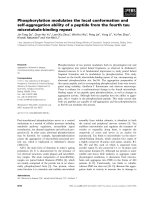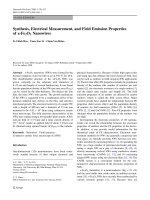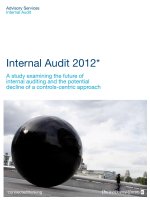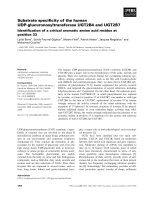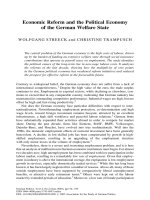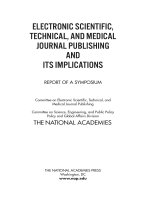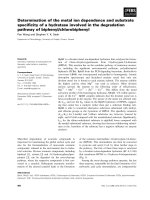Economic production and oil recovery efficiency of a lip 2016 achievements i
Bạn đang xem bản rút gọn của tài liệu. Xem và tải ngay bản đầy đủ của tài liệu tại đây (965.44 KB, 9 trang )
Achievements in the Life Sciences 10 (2016) 102–110
Contents lists available at ScienceDirect
Achievements in the Life Sciences
journal homepage: www.elsevier.com/locate/als
Economic Production and Oil Recovery Efficiency of a Lipopeptide
Biosurfactant from a Novel Marine Bacterium Bacillus simplex
Panagal Mani a, Pethanen Sivakumar b, Shanmugasundaram Senthil Balan c,⁎
a
b
c
Department of Biotechnology, Annai College of Arts and Science, Kumbakonam, Tamil Nadu-612503, India
Department of Zoology, Arumugam Pillai Seethai Ammal College, Tirupputtur, Tamil Nadu-630211, India
Department of Medicinal Plant Biotechnology, Sharmila Institute of Medicinal Products Research Academy, Thanjavur, Tamil Nadu-613007, India
a r t i c l e
i n f o
Article history:
Received 12 January 2016
Received in revised form 29 May 2016
Accepted 31 May 2016
Available online 16 June 2016
Keywords:
Bacillus simplex
Crude oil recovery
Lipopeptide surfactant
Marine bacterium
Sunflower oil cake
a b s t r a c t
The use and commercial applications of biosurfactants in the petroleum industries have been
raised during the past decades. Marine bacteria and their efficiency in crude oil recovery has
been less studied than terrestrial strain, hence this present study. A novel marine bacterium
Bacillus simplex having promising biosurfactant production was isolated from a petroleum
hydrocarbon-contaminated coastal sea sediment samples of Nagapattinam fishing harbor,
Tamil Nadu, India. This strain showed most economical biosurfactant production with an
agro-industrial waste substrate, sunflower oil cake at 54th h time incubation along with the
cultural conditions of 20 ppt salinity, 35 °C temperature, and pH 7. The produced biosurfactant
was purified, which was accounted at 908 ± 7 mg/L on dry weight basis. The biosurfactant
was identified as lipopeptide with a molecular mass of 1111.1 Da which was deduced using
TLC, biochemical estimation methods, FT-IR, NMR, and MALDI-TOF MS analysis. Furthermore,
this purified lipopeptide surfactant showed consistent and enhanced crude oil recovering
efficiency under different salinity conditions (0–30%). Based on the above facts, the isolated
novel marine bacterium proved its cheaper production of novel biosurfactant and its promising
oil recovering efficiency even at hypersaline conditions. Further, this is the first report of a
biosurfactant from the bacterium Bacillus simplex.
© 2016 Far Eastern Federal University. Hosting by Elsevier B.V. This is an open access article
under the CC BY-NC-ND license ( />
Introduction
Surfactants are amphipathic molecules with both hydrophilic and hydrophobic moieties that partition preferentially at the interface between fluid phases that have different degrees of polarity and hydrogen bonding, such as oil and water or air and water
interfaces (Banat et al., 2000). Almost all surfactants that are currently being produced are derived from petroleum compounds.
However, these synthetic surfactants are usually toxic themselves and hardly degraded by microorganisms. Therefore, they are
potential sources of pollution and damage to the environment. These hazards associated with synthetic surfactants have, in recent
years, drawn much attention to the microbial production of surfactants called biosurfactants (Urum and Pekdemir, 2004).
Biosurfactants have several advantages over synthetic surfactants with respect to high biodegradability, low toxicity, good biocompatibility, chemical diversity, greater stability, etc. These properties contribute its great demands in diverse industrial applications such as cosmetics, food, pharmaceutics, agriculture, and petrochemicals (Lotfabada et al., 2009). Petrochemical industries
⁎ Corresponding author at: Tel.: +91 9486198685.
E-mail address: (S.S. Balan).
Peer review under responsibility of Far Eastern Federal University.
/>2078-1520/© 2016 Far Eastern Federal University. Hosting by Elsevier B.V. This is an open access article under the CC BY-NC-ND license
( />
P. Mani et al. / Achievements in the Life Sciences 10 (2016) 102–110
103
have attracted more attention because only 30% of oil in the reservoir can be recovered using primary and secondary recovery
techniques (Banat, 1995) and tertiary oil recovery that could recover the residual oil using microorganisms or their products
like biosurfactants. Biosurfactant molecules reduce the capillary forces that retain the oil in the reservoir, decreases oil viscosity
and surface tension, increases emulsification etc., thus promoting its easy flow and resulting increased oil recovery. Nowadays,
biosurfactants are mostly preferred in petroleum industries as well as bioremediation applications based on their excellent
activities and from an ecological safety perspective (Desai and Banat, 1997).
Till date, many studies have been carried out with different microbes to explore the biosurfactant applications and its activity
delivering different industrial and environmental significance of these compounds. Despite the fact that marine environment
forms a vast majority of the Earth's surface as well as comprising a wealthy basin of diverse microorganisms (Satpute et al.,
2010), moreover, marine microbes have been reported for unique metabolic and physiological capabilities to thrive in extreme
habitats and produce novel metabolites which are not often present in terrestrial isolates (Jensen and Fenical, 1994). However,
very few literature has been solely reported about the marine bacterial isolates for biosurfactant production and its efficiency
on enhanced oil recovery when compared to terrestrial isolates. Furthermore, only one commercialized industrial biosurfactant
of marine origin which is in use for enhanced oil recovery that is “Emulsan” produced by marine Acinetobacter calcoaceticus
RAG-1, isolated from the Mediterranean Sea, has been marketed by Petroferm Research Inc., Amelia Island, FL, USA (Kosaric
and Gray, 1987).
Based on the above facts, the present study undertook an investigation from the coastal region of Nagapattinam Fishing
Harbor, Tamil Nadu, India for the effective isolation of a potential marine biosurfactant producer, its economic production using
cheaper substrates, purification, and biochemical characterization and its crude oil recovering efficiency. To the best of our
knowledge, the sampling site was unexplored earlier for the potent biosurfactant producer, and this site is highly contaminated
by petroleum hydrocarbon compounds through the regular operating more than 300 mechanized boats for fishing where the
probability of achieving most potential biosurfactant producers is expected to be high (Walter et al., 2010).
Materials and Methods
Isolation and Screening of Potential Bacteria
Coastal sea sediment samples were collected using the Petersen grab sampler from three different contaminated locations of
Nagapattinam fishing harbor, Tamil Nadu, India. During collection, aseptic methods were strictly applied and the samples were
transferred to pre-sterilized 250 ml screw type bottle containers which were kept maintained at 4 °C in an ice box and were
processed immediately in the lab. One gram of the central portion of the collected samples was serially diluted and spread plated
on sea water prepared Bushnell Hass (SWBH) agar containing 0.1% crude oil. After week incubation, the morphological distinct
colonies were pure cultured on sea water prepared nutrient agar. All the individual bacterial strains were freshly inoculated for
SWBH broth containing 0.1% crude oil and tested for biosurfactant production using oil spreading test (Youssef et al., 2004).
The strain showing maximum activity was used for further characterization of the biosurfactant.
Molecular Identification of the Potential Strain
Molecular identification of the potential strain was referred with 16S rRNA gene sequence analysis using the bacterial universal primer set of Eubac 27F (5′-AGAG TTTG ATCM TGGC TCAG-3′) and 1492R (5′-GGTT ACCT TGTT ACGA CTT-3′). The PCR was
done on a thermal cycler (Eppendorf) with 50 μl reaction mix. The reaction mix contained 10 × amplification buffer (5 μl),
1.5 mM MgCl2 (5 μl), 1 μl of each forward and reverse primer, 1 μl dNTP, and 0.25 μl Taq polymerase. After an initial denaturation
at 95 °C for 1 min, amplification was carried out with 35 cycles of 35 s at 94 °C, 40 s at 55 °C, 2 min at 72 °C followed by a final
extension for 8 min at 72 °C. The PCR products were analyzed by electrophoresis using 1.2% agarose gel (Genei). The 16S rRNA
gene sequence obtained from the potential bacterium was compared with other bacterial sequences by using NCBI megaBLAST
( for their pairwise identities. Phylogenetic analysis was done using the neighbor-joining
tree based on the Maximum Composite Likelihood model with MEGA 6.0 (www.megasoftware.net).
Fermentation Conditions
The potential strain was standardized for maximum biosurfactant production by adopting search technique, i.e., varying one
parameter at a time. The fermentation process was carried out in a 3 L laboratory fermentor (Scigenics, India) with 2.1 L working
volume using SWBH broth as the basal medium with the basal culture conditions of pH 8.0, 37 °C temperature, 34 ppt salinity,
agitation at 150 rpm, and aeration at 1.0 VVM. In addition to that, accepta 2904 was used as an antifoaming agent on the required
basis within the concentration of 10–50 ppm. The inoculum was prepared with the exponential phase culture of the potential
strain using Zobell marine broth where the optical density (OD 620 nm) of the inoculum culture was adjusted to 0.1 as per
the procedure of McFarland turbidity 0.5 standard which was equivalent to the bacterial concentration of 1 × 108 CFU/ml. The
biosurfactant production was monitored using 24 h emulsification index (E24) (Sheppard and Mulligan, 1987).
104
P. Mani et al. / Achievements in the Life Sciences 10 (2016) 102–110
Influence of Different Economic Substrates and Time Course on Biosurfactant Production
Different agro-industrial waste products were examined as the cheaper nutritional source for the enhanced biosurfactant production. Various cheaper substrates such as peanut oil cake, coconut oil cake, mustard oil cake, palm oil cake, and sunflower oil
cake with 2% (v/w) were individually determined in the basal mineral medium for maximum biosurfactant production. For time
course of biosurfactant production, the production medium was monitored for 120 h with an interval of 6 h starting from the lag
phase to stationary phase under batch culture conditions during which the production peak time was determined. The time
course on production was plotted with reference to biosurfactant production and bacterial growth.
Recapitulation of pH, Temperature, and Salinity Condition
Standardizing optimal parameters like salinity, temperature, and pH conditions play a vital role in fermentation progress for
maximum production. The effect of various salinity parameters was standardized between 0 and 34 ppt (0, 10, 20, 30, 34 ppt),
which was prepared by diluting the purified natural sea water, likewise, the influence of different temperature conditions from
25–45 °C were applied to the production medium. Further, different pH conditions between pH 6 and 9 were tested for the effective medium optimization.
Biosurfactant Purification
At the standardized cultural conditions, the cell-free supernatant was subjected to the acid precipitation method (Nitschke and
Pastore, 2006) for recovering the crude biosurfactant and the acidified biosurfactant was neutralized using phosphate buffer
(pH 7) solution. The crude extract was dissolved in 5 ml of acetonitrile, filtered through a 0.2 μm syringe filter and separated
by Reverse Phase (RP)—C18 silica gel (230–400 mesh) column held at room temperature. The solvent system consisted of distilled
water (solvent A) and acetonitrile (solvent B). The compounds were eluted at a flow rate of 0.5 ml/min with a stepwise gradient
from the mixture A:B (0:100, vol/vol) to A:B (100:0, vol/vol) and the ratio were designed as 0:100, 2.5:97.5, 5: 95, 7.5:92.5 to
100:0 (vol/vol). Forty-one fractions were collected which were rotary vacuum evaporated and every fraction was screened for
the emulsification index (E24). The purity of biosurfactant was checked by thin layer chromatography and the fraction showing
maximum activity was lyophilized for further studies.
Biochemical Characterization and Molecular Weight Determination
For biochemical characterization, the purified biosurfactant was initially determined for biochemical characterization using silica gel TLC plate and the chromatograms were developed with 96% ethanol:water (7:3) for peptide, chloroform:acetic acid:water
(60:30:10) for sugars, and chloroform:methanol:water (65:25:4) for lipids. Visualizing reagents used were ninhydrin reagent to
detect peptides, anthrone reagent to examine sugars, and lipid portion was evidenced using rhodamine B reagent, followed by
estimating its total content of protein, carbohydrate, and lipid using Lowry's method (Lowry et al., 1951), phenol sulphuric acid
method (Dubois et al., 1956), and total free fatty acids (Folch et al., 1957), respectively. FT-IR and NMR was used for further analysis of this biosurfactant to elucidate its functional groups. One milligram of freeze-dried biosurfactant was grounded with 100 mg
of KBr. Infrared absorption spectra were recorded on a Thermo Niocolet, AVATAR 330 FT-IR system with a spectral resolution and
a wave number accuracy of 4 and 0.01 cm−1, respectively, and a KBr pellet was used as the background reference. 1H NMR spectra of the biosurfactant were recorded on a Bruker AV600 NMR spectrometer (Germany) using deuterated chloroform (CDCl3) as
the solvent. Chemical shifts were expressed in parts per million (ppm) down field from an internal standard of tetra methylsilane
(TMS). MALDI-TOF MS was used to determine the molecular weight of this purified biosurfactant. MS was analyzed using a Voyager DE-Pro MALDI-TOF spectrometer (Applied Biosystems, Inc., CA, USA) in reflector mode with an accelerating voltage of 20 kV.
Equal volume (2 μl) of the purified sample fraction was mixed with the equal volume of matrix solution, i.e. 0.1% a-cyano-4hydroxycinnamic acid in acetonitrile–water–TFA (50:50:0.01, vol/vol/vol). After proper mixing, the sample was spotted on the
target plate, dried, and placed inside the sample cabinet. Molecules were separated based on their mass and were detected by
the ion detector set in reflector mode.
Application of Biosurfactant in Crude Oil Removal from Contaminated Sand
The application of the purified lipopeptide surfactant on enhanced oil recovery was estimated as per the earlier method described by Sobrinho et al. (2008) with some modification in which the acid washed beach sand impregnated with 5.0 ml of
crude oil was used instead of waste motor oil per 100 g of soil in the recovery process as well as different salinity conditions
were applied to the experimental setup to envisage biosurfactant efficiency on oil recovery. Experiments were carried out
using 20 g crude oil impregnated sand with the addition of 60 ml of 100 μg/ml biosurfactant concentrations in 250 ml conical
flasks under different salinity conditions ranging from 0 to 30% salinity. The different salinity conditions were applied using artificial sea salt (Himedia, India); in the abovementioned experiments, setup and controls were used for every parameter using the
synthetic surfactant, sodium lauryl sulphate (SLS) as positive control and distilled water without added any surfactant as negative
control. The experimental samples were incubated under rotary shaker conditions (150 rpm) and incubated for 24 h. After incubation, the samples were centrifuged at 5000 g for 20 min for the separation of the laundering solution and the sand. The
P. Mani et al. / Achievements in the Life Sciences 10 (2016) 102–110
105
remaining amount of oil residing in the sand after the oil recovery by the biosurfactant action was gravimetrically determined as
the amount of material extracted from the sand by hexane.
Analytical Methods
The oil spreading test was done by adding 20 ml of distilled water to a Petri dish with a diameter of 8 cm in which 15 μl of
crude oil was dropped to form a thin oil layer on the surface of the water and then 10 μl of a centrifuged supernatant was added
onto the surface of the oil. The diameter of the clear zone was observed under light and measured. The E24 was evaluated with
crude oil added to cell free broth in a ratio of 1:1 and vortexed vigorously for 2 min. After 24 h incubation, the height of the emulsified layer was measured and divided by the total height of the liquid layer and multiplied by 100. Both the tests were conducted
at room temperature (26–28 °C). For the estimation of the dry weight of cell biomass on biosurfactant production, culture broth
was centrifuged at 3000 rpm for 15 min and the obtained cell pellet was hot air oven dried and weighed. All the values were
expressed as mean ± standard deviation of three replicate experiments.
Results and Discussion
Screening and Identification for Potential Biosurfactant Bacteria
The procured sediment samples were serially diluted using sterile natural sea water and spread plated on SWBH agar containing 0.1% crude oil. After incubation, the plates were visualized for distinct morphological colonies which were isolated and pure
cultured on sea water prepared nutrient agar. There were 23 morphological distinct bacterial strains were obtained which were
named as SBN 1–23 and screened for biosurfactant production using oil spreading method. Among the isolates, the strain SBN 19
showed maximum activity of 54 ± 2 mm in oil spreading test, whereas the other strains showed lesser activity than it. The
present study used oil spreading method for the effective screening, which is a reliable method to detect and screen potential producers from diverse microorganisms (Plaza et al., 2006), and the method is rapid, which can be applied when the activity and
quantity of biosurfactant are low (Youssef et al., 2004). The phylogenetic position of the strain was examined by BLAST analysis
and the results revealed that the strain belongs to the genus Bacillus of the family Bacillaceae. Based on the sequence homology,
the strain SBN 19 showed the highest similarity of more than 99% with Bacillus simplex WN570. Following these comparisons, the
strain was identified as Bacillus simplex SBN 19 and the 16S rRNA sequence was deposited in GenBank with the accession number
KU170605. Phylogenetic tree of Bacillus simplex SBN 19 was plotted with their closest NCBI strains using the neighbor-joining tree
based on the Maximum Composite Likelihood model (Fig. 1). This strain was chosen for the further characterization based on its
biosurfactant activity, and this strain has not been reported earlier for the biosurfactant characterization.
Fig. 1. Phylogenetic analysis was performed for the potential strain Bacillus simplex SBN 19 with their closest NCBI (BLASTn) strains based on the 16S rRNA gene
sequences. This analysis was done using the neighbor-joining tree based on the Maximum Composite Likelihood model with MEGA 6.0. Numbers at nodes indicate
levels of bootstrap values (expressed as percentages of 1000 replications) and the black dot indicates the potential strain of this study.
106
P. Mani et al. / Achievements in the Life Sciences 10 (2016) 102–110
Standardization of Economic Substrate and Time Course on Biosurfactant Production
Different agro-industrial waste substrates were chosen for the examination of economic and enhanced biosurfactant
production. All the examined cheaper source showed biosurfactant production above 50% E24, but the maximum production
was observed using sunflower oil cake with 67.2 ± 1.5 E24 (Fig. 2a). The production of biosurfactant with cheaper substrates
like oil cakes offers good alternative to traditional applications by their exploitation in the production of environmentally friendly
green products. Fermentation processes utilizing oil cakes are attractive due to its relatively cheaper availability throughout the
year, which makes it even more favorable when economics is considered (Ramachandran et al., 2007). Similar to this, Thavasi
et al. (2011) used peanut oil cake for the production of biosurfactant from a marine Pseudomonas aeruginosa. The time course
of biosurfactant production by Bacillus simplex as a function of time (Fig. 2b) depicted that the biosurfactant secretion was
detected when the organism was in the early logarithmic phase of bacterial growth, which achieved its maximum during the
end logarithmic phase or initiation of the stationary growth phase of the bacterium (54th h). Further, the maximum emulsification activity of 67.3 ± 3 was maintained till the predicted time course of the stationary phase with 8.49 ± 0.5 cell biomass. The
production profile of biomass and biosurfactant as a function of time revealed that it was primary metabolite (Khopade et al.,
2012). An earlier report also suggested that a similar growth-dependent pattern of biosurfactant production was observed in
case of a marine Bacillus megaterium (Thavasi et al., 2008).
Fig. 2. Influence of different cheaper substrates (a) and time course (b) on biosurfactant production from a marine Bacillus simplex SBN 19.
P. Mani et al. / Achievements in the Life Sciences 10 (2016) 102–110
107
Recapitulation of Salinity, Temperature, and pH Condition
Since the bacterium is off from marine origin, so the optimization of salinity conditions makes an important estimation about
the affinity of the organism to the salt concentration. The isolated strain showed maximum production of biosurfactant at 20 ppt
with 74.7 ± 2.5% E24 (Fig. 3a). Furthermore, the strain showed much decreased biosurfactant production as well as growth with
decreasing salinity concentration which proved its strong adaptation in the marine environment. However, Kiran et al. (2009)
observed that the 30 ppt salinity concentration showed maximum biosurfactant production with marine-derived fungus
Aspergillus ustus MSF3. Regarding optimization for determining optimum temperature, the strain showed a strong dependence
on biosurfactant production with varying temperature conditions and the peak production was achieved in 35 °C with 75.7 ±
2.2% E24 and lowest activity was observed in 45 °C with 37.2 ± 2.2% E24 (Fig. 3b). Close to this, the optimal temperature for
maximum rhamnolipid production by Pseudomonas aeruginosa J4 strain begins from 30 to 37 °C (Wei et al., 2005). The other important characteristic of most organisms is their strong dependence on the pH for cell growth and the production of metabolites.
The isolated strain showed the highest biosurfactant production at pH 7.0 with 79.4 ± 2.2% E24 (Fig. 3c); further, the isolated
Fig. 3. Effect of salinity (a), temperature (b), and pH (c) on biosurfactant production from a marine Bacillus simplex SBN 19.
108
P. Mani et al. / Achievements in the Life Sciences 10 (2016) 102–110
Fig. 4. FT-IR (a), NMR spectrum (b), and MALDI-TOF mass spectrometry (c) of a lipopeptide surfactant from a marine Bacillus simplex SBN 19.
P. Mani et al. / Achievements in the Life Sciences 10 (2016) 102–110
109
strain showed lowest biosurfactant production at acidic conditions below 6. Similar to the present investigation, the result observed by Mawgoud et al. (2008) revealed maximum biosurfactant production at pH 7 using B. subtilis.
Purification and Biochemical Characterization of Biosurfactant
From the optimized conditions, the crude biosurfactant was extracted by acid precipitation technique, and further, it was
purified using silica gel column chromatography. The maximum emulsification activity of 89 ± 2.3% E24 was observed at the
45:55 acetonitrile:water fraction which was accounted at 908 ± 7 mg/L on dry weight basis. The purified biosurfactant was analyzed for the presence of biochemical components using silica gel TLC plates, which showed peptide and lipid components at Rf
values of 0.53 and 0.65, respectively. On biochemical estimating methods, the isolated biosurfactant showed the presence of 81 ±
0.8% protein and 19 ± 0.1% lipid and the carbohydrate was found to be absent. The biosurfactant was further confirmed to be
lipopeptide nature based on the FT-IR and NMR spectral analysis (Fig. 4a and b). Significant absorption peak at 3412 cm−1 region
exhibited the N–H stretching vibration of peptides. The characteristic absorbance at 1656 cm−1 predicted the stretching mode of
CO–N bond and the peak at 1544 cm−1 evidenced the deformation mode of the N–H bond combined with C–N stretching. The
important absorbance peaks at 723, 1409, 1454, 2856, and 2926 cm−1 revealed the existence of aliphatic long hydrocarbon
chain of the biosurfactants. Other important peak observed at 941 showed the presence of hydroxyl group (OH) present in the
amino acid.
The 1H NMR results also showed that the presence of a long aliphatic chain (CH2)n was observed between
1.2328–2.6320 ppm, simultaneously, the CH2–OH group of the amino acid was predicted at the 4.0398–4.7186 ppm. The important absorption peak of hydrogen atom in the amide group (C _ O–NH) was observed between 5.6907–8.0790 ppm and hydrogen atom of the group CH2C _ O was predicted at 2.9048–3.2358 ppm which revealed the conjugation between the amino acids
and the fatty acid. Further, the chemical complex studied using FT-IR and NMR spectral analysis showed the evidence of peptide
and aliphatic long hydrocarbon fatty acid chain. The functional group analysis carried out in the present investigation corroborates
with the similar pattern of wave numbers and functional groups observed for lipopeptide surfactants from different research
(Pereira et al., 2013; de-Faria et al., 2011; Pornsunthorntawee et al., 2008). The molecular weight of this lipopeptide surfactant
was studied using MALDI-TOF spectral analysis, which revealed a cluster of three molecules at m/z 1112.1, 1134.1, and 1150.1.
These molecules were attributed to the protonated ion and to the adducts of sodium and potassium ions (Fig. 4c). The molecular
mass of this lipopeptide is 1111.1 Da, and this molecular weight was different from the earlier reports which represent it as new
lipopeptide surfactants.
Application of Biosurfactant in Crude Oil Removal from Contaminated Sand
In the present study, the purified lipopeptide surfactant was used for enhanced crude oil recovery from the contaminated sand
under different salinity conditions. The biosurfactant revealed a consistent and promising oil recovery rate on all the tested
different parameters (Fig. 5). The maximum tested salinity concentration of 30% showed 84.7 ± 2.4% crude oil recovery, which
was very close result to the peak recovery rate examined at 0% salinity (87.4 ± 1.7%). But the positive control using SLS removed
maximum concentration of crude oil at 0% salinity (63.4%) whereas removed only 22.9% at the highest tested concentration of 30%
salinity. This comparative observation clearly evidenced the consistent crude oil recovering efficiency of this new lipopeptide
surfactant even at extreme salinity conditions. The negative control using distilled water without any added surfactant removed
Fig. 5. Comparison of crude oil recovering efficiency of a lipopeptide surfactant from a native marine Bacillus simplex SBN 19 with the positive control using the
synthetic surfactant, SLS, and the negative control using distilled water at different salinity conditions.
110
P. Mani et al. / Achievements in the Life Sciences 10 (2016) 102–110
only 7.1–7.9% of crude oil from the sand. Further, these results hold as the significant data for the promising application of this
isolated biosurfactant in petroleum industries for enhanced oil recovery and cleaning of oil contaminants, reducing oil viscosity
during crude oil transportation as well as for bioremediation, in particular, this biosurfactant can act excellently even at severe
salinity condition.
Conclusion
The isolated novel marine bacterium Bacillus simplex in the present study showed a significant response to all the cheaper
substrates utilized; in particular, the maximum production was observed with the sunflower oil cake which evidenced its most
economical cheaper production. The purified lipopeptide surfactant exhibited a different molecular mass than the earlier reports
which constituted it as a novel compound. Furthermore, an interesting observation on enhanced and consistent crude oil
recovering efficiency at wide range of salinity parameters proved that it could be an ideal product for the petroleum industries
as well as environmental applications even at hypersaline environmental conditions.
Conflict of Interest
The authors declare that they have no competing interests.
Acknowledgment
The authors very gratefully acknowledge Shri R. J. Antony Raj, Chairman and Mrs. A. Agnes Antony Raj, Secretary, SIMPRA,
SIRO Institution, Thanjavur, Tamil Nadu, India, for providing lab facilities and supporting our research.
References
Banat, I.M., 1995. Biosurfactants production and possible uses in microbial enhanced oil recovery and oil pollution remediation: a review. Bioresour. Technol. 51, 1–12.
Banat, I.M., Makkar, R.S., Cameotra, S.S., 2000. Potential commercial applications of microbial surfactants. Appl. Microbiol. Biotechnol. 53, 495–508.
de-Faria, A.F., Teodoro-Martinez, D.S., de-Oliveira Barbosa, G.N., Vaz, B.G., Silva, I.S., Garcia, J.S., Totola, M.R., Eberlin, M.N., Grossman, M., Alves, O.L., Durrant, L.R., 2011.
Production and structural characterization of surfactin (C14/Leu7) produced by Bacillus subtilis isolate LSFM-05 grown on raw glycerol from the biodiesel industry.
Process Biochem. 46, 1951–1957.
Desai, J.D., Banat, I.M., 1997. Microbial production of surfactants and their commercial potential. Microbiol. Mol. Biol. Rev. 61, 47–64.
Dubois, M., Gilles, K.A., Hamilton, J.K., Rebers, P.A., Smith, F., 1956. Colorimetric method for determination of sugars and related substances. Anal. Chem. 28, 350–356.
Folch, J., Lees, M., Sloane-Stanley, G.H., 1957. A simple method for the isolation and purification of total lipides from animal tissues. J. Biol. Chem. 226, 497–509.
Jensen, P.R., Fenical, W., 1994. Strategies for the discovery of secondary metabolites from marine bacteria: ecological perspectives. Annu. Rev. Microbiol. 48, 559–584.
Khopade, A., Ren, B., Liu, X., Mahadik, K., Zhang, L., Kokare, C., 2012. Production and characterization of biosurfactant from marine Streptomyces species B3. J. Colloid
Interface Sci. 367, 311–318.
Kiran, G.S., Hema, T.A., Gandhimathi, R., Selvin, J., Thomas, T.A., Ravji, T.R., Natarajaseenivasan, K., 2009. Optimization and production of a biosurfactant from the sponge
associated marine fungus Aspergillus ustus MSF3. Colloids Surf. B: Biointerfaces 73, 250–256.
Kosaric, N., Gray, N.C.C., 1987. Cairns WL. Introduction: Biotechnology and the surfactant industry. In: Kosaric, N., Cairns, W.L., Gray, N.C.C. (Eds.), Biosurfactants and
BiotechnologySurfactant Science Series vol. 25. Marcel Dekker, Inc., New York, pp. 1–19.
Lotfabada, T.B., Shourianc, M., Reza, R., 2009. An efficient biosurfactant-producing bacterium Pseudomonas aeruginosa MR01, isolated from oil excavation areas in south
of Iran. Colloids Surf. B: Biointerfaces 11, 445–3455.
Lowry, O.H., Rosenbrough, N.J., Farr, A.L., Randall, R.J., 1951. Protein measurement with the folin phenol reagent. J. Biol. Chem. 193, 265–275.
Mawgoud, A.M.A., Aboulwafa, M.M., Hassouna, N.A., 2008. Characterization of surfactin produced by Bacillus subtilis isolate BS5. Appl. Biochem. Biotechnol. 150,
289–303.
Nitschke, M., Pastore, G.M., 2006. Production and properties of a surfactant obtained from Bacillus subtilis grown on cassava wastewater. Bioresour. Technol. 97,
336–341.
Pereira, J.F.B., Gudina, E.J., Costa, R., Vitorino, R., Teixeira, J.A., Coutinho, J.A.P., Rodrigues, L.R., 2013. Optimization and characterization of biosurfactant production by
Bacillus subtilis isolates towards microbial enhanced oil recovery applications. Fuel 111, 259–268.
Plaza, G., Zjawiony, I., Banat, I., 2006. Use of different methods for detection of thermophilic biosurfactant-producing bacteria from hydrocarbon contaminated
bioremediated soils. J. Pet. Sci. Eng. 50, 71–77.
Pornsunthorntawee, O., Arttaweeporn, N., Paisanjit, S., Somboonthanate, P., Abe, M., Rujiravanit, R., Chavadej, S., 2008. Isolation and comparison of biosurfactants
produced by Bacillus subtilis PT2 and Pseudomonas aeruginosa SP4 for microbial surfactant-enhanced oil recovery. Biochem. Eng. J. 42, 172–179.
Ramachandran, S., Singh, S.K., Larroche, C., Soccol, C.R., Pandey, A., 2007. Oil cakes and their biotechnological applications – a review. Bioresour. Technol. 98,
2000–2009.
Satpute, S.K., Banat, I.M., Dhakephalkar, P.K., Banpurkar, A.G., Chopade, B.A., 2010. Biosurfactants, bioemulsifiers and exopolysaccharides from marine microorganisms.
Biotechnol. Adv. 28, 436–450.
Sheppard, J.D., Mulligan, C.N., 1987. The production of surfactin by Bacillus subtilis grown on peat hydrolysate. Appl. Microbiol. Biotechnol. 27, 110–116.
Sobrinho, H.B.S., Rufino, R.D., Luna, J.M., Salgueiro, A.A., Takaki, G.M.C., Leite, L.F.C., Sarubbo, L.A., 2008. Utilization of two agro industrial by-products for the production
of a surfactant by Candida sphaerica UCP0995. Process Biochem. 43, 912–917.
Thavasi, R., Jayalakshmi, S., Balasubramanian, T., Banat, I.M., 2008. Production and characterization of a glycolipid biosurfactant from Bacillus megaterium using
economically cheaper sources. World J. Microbiol. Biotechnol. 24, 917–925.
Thavasi, R., Subramanyam Nambaru, V.R.M., Jayalakshmi, S., Balasubramanian, T., Banat, I.M., 2011. Biosurfactant production by Pseudomonas aeruginosa from
renewable resources. Indian J. Microbiol. 51, 30–36.
Urum, K., Pekdemir, T., 2004. Evaluation of biosurfactants for crude oil contaminated soil washing. Chemosphere 57, 1139–1150.
Walter, V., Syldatk, C., Hausmann, R., 2010. Screening concepts for the isolation of biosurfactant producing microorganisms. Adv. Exp. Med. Biol. 672, 1–13.
Wei, Y.H., Chou, C.L., Chang, J.S., 2005. Rhamnolipid production by indigenous Pseudomonas aeruginosa J4 originating from petrochemical wastewater. Biochem. Eng. J.
27, 146–154.
Youssef, N., Duncan, K., Nagle, D., Savage, K.N., Knapp, R.M., McInerney, M.J., 2004. Comparison of methods to detect biosurfactant production by diverse microorganisms. J. Microbiol. Methods 56, 339–347.


